•••
The Golden Glow
As Michael J. Brody Jr. had explained to the press in Jamaica and New York, the fortune he inherited came from his family’s margarine business. Margarine was about 100 years old in 1970, and Brody’s family had been involved early on. In the late 1860s, French Emperor Louis Napoleon III had been looking for a butter substitute that could be used to feed his troops. He offered a prize for anyone who could come up with an appropriate and cheap butter substitute. At the time, Hippolyte Mège-Mouriés, a French chemist, was working with fatty acids that had been discovered in 1813 and named by another French chemist, Michel Eugène Chevreul. Chevreul discovered both oleic acid and stearic acid. Chevreul also thought he had discovered a third fatty acid. Because the droplets of this new discovery were shiny and round, Chevreul named it margaric acid, after the Greek word for pearl, μαργαριτάρι, which is pronounced, margaritári.
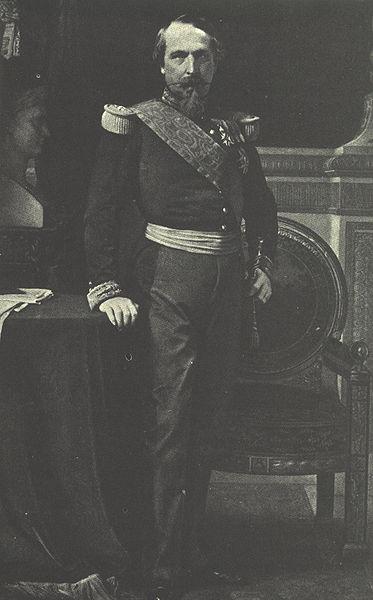 In 1868, Mège-Mouriés won the prize offered by Napoleon III with a substance that used Chevreul’s margaric acid. Mège-Mouriés called his invention oleomargarine. The name was descriptive: “Oleo” from “oleum,” the Latin word for “oil,” and “margarine” from “margaric acid.” Mège-Mouriés’ concoction would hardly be recognized as today’s margarine. Basically he mixed beef fat with milk. The more detailed description is even less appetizing. In 1886, a pamphlet entitled Oleomargarine and Butterine, and subtitled “A plain presentation of the most gigantic swindle of modern times,” described Mège-Mouriés’s invention. Oleomargarine was “the basis of all the frauds in butter,” the outcome of Mège-Mouriés’s observation that butter diffused through the milk of the cow was a result of the absorption of the animal’s fat. Determined to replicate this natural process, Mège-Mouriés dumped minced beef suet, several sheep stomachs cut into small pieces and a little carbonate of potash into a kettle of water, which he then heated to 113 degrees Fahrenheit. The heat and the pepsin in the sheeps’ stomach separated the beef fat from muscle, tendons and other tissues in the suet. The liquid fat was skimmed from the surface, poured into molds and allowed to cool into a solid form. The congealed fat was then wrapped in cloth and squeezed in a hydraulic press. Margaric acid oozed out in liquid form. Left behind in the cloth was the lumpy stearic acid. Mège-Mouriés then churned ten pounds of the margaric acid with four pints of milk and three pints of water. The resulting compound was then let harden. The end result of this process was a pearl-white substance somewhat similar in texture to butter that did not melt at room temperature. In taste, it lacked the sweetness of butter but, because of the high fat content, was palatable and passably reminiscent of the dairy product. When color was added, the margarine had a buttery-yellow hue.
In 1868, Mège-Mouriés won the prize offered by Napoleon III with a substance that used Chevreul’s margaric acid. Mège-Mouriés called his invention oleomargarine. The name was descriptive: “Oleo” from “oleum,” the Latin word for “oil,” and “margarine” from “margaric acid.” Mège-Mouriés’ concoction would hardly be recognized as today’s margarine. Basically he mixed beef fat with milk. The more detailed description is even less appetizing. In 1886, a pamphlet entitled Oleomargarine and Butterine, and subtitled “A plain presentation of the most gigantic swindle of modern times,” described Mège-Mouriés’s invention. Oleomargarine was “the basis of all the frauds in butter,” the outcome of Mège-Mouriés’s observation that butter diffused through the milk of the cow was a result of the absorption of the animal’s fat. Determined to replicate this natural process, Mège-Mouriés dumped minced beef suet, several sheep stomachs cut into small pieces and a little carbonate of potash into a kettle of water, which he then heated to 113 degrees Fahrenheit. The heat and the pepsin in the sheeps’ stomach separated the beef fat from muscle, tendons and other tissues in the suet. The liquid fat was skimmed from the surface, poured into molds and allowed to cool into a solid form. The congealed fat was then wrapped in cloth and squeezed in a hydraulic press. Margaric acid oozed out in liquid form. Left behind in the cloth was the lumpy stearic acid. Mège-Mouriés then churned ten pounds of the margaric acid with four pints of milk and three pints of water. The resulting compound was then let harden. The end result of this process was a pearl-white substance somewhat similar in texture to butter that did not melt at room temperature. In taste, it lacked the sweetness of butter but, because of the high fat content, was palatable and passably reminiscent of the dairy product. When color was added, the margarine had a buttery-yellow hue.
Margarine quickly caught on in the United States in the 1870s. Because of the use of animal fat, Mège-Mouriés’s invention and other similar substitutes using animal fat as an ingredient were sometimes called lardine or suine but, more often, oleomargarine or butterine. Gradually, oleomargarine gained linguistic acceptance and was eventually shorted to either “oleo” or “margarine.” Oleomargarine was good business in America in the 1870s and early 1880s. But it was also a rough and deceptive business, full of counterfeiters, flimflam artists, moonshiners and hucksters. In Life on the Mississippi, published in 1883, Mark Twain described a meeting on a riverboat between two drummers. One was a margarine dealer from Cincinnati and the other a cottonseed oil dealer from New Orleans. They were “[b]risk men, energetic of movement and speech; the dollar their god, how to get it their religion.” According to the Cincinnati dealer, margarine would soon eclipse butter. The drummer bragged about his company’s oleomargarine, which could be passed off as butter because it was identical in taste and appearance: “You can't tell it from butter; by George, an EXPERT can't.” His company supplied oleo to the boats on the Mississippi and was working on the hotels. It was turning out oleo by the thousands of tons and there was no end in sight. “Butter’s had its DAY—and from this out, butter goes to the wall,” he said. “There’s more money in oleomargarine than—why, you can’t imagine the business we do.” Not to be outdone, the New Orleans drummer pointed out that cottonseed oil, with some manipulation and creative packaging, could be sold as olive oil from France or Italy, and that there was big business there, too. It was all a matter of packaging.
The prediction by the Cincinnati oleomargarine dealer that butter would disappear did not come true because of a fierce backlash by the American dairy farmers. At the time Twain wrote Life on the Mississippi, agriculture in America was still conducted by family-owned farms, most under 100 acres. The farmers often made additional money by making and selling butter, either directly to consumers or to commission merchants. Other farmers supplied milk to the fledging commercial butter industry. Margarine was a threat. It used considerably less milk than butter and therefore cost less for the consumer. Also, the family farmer could not easily produce margarine on the farm. As a result, margarine was seen as an upstart big-business product that threatened the livelihood of dairy farmers.
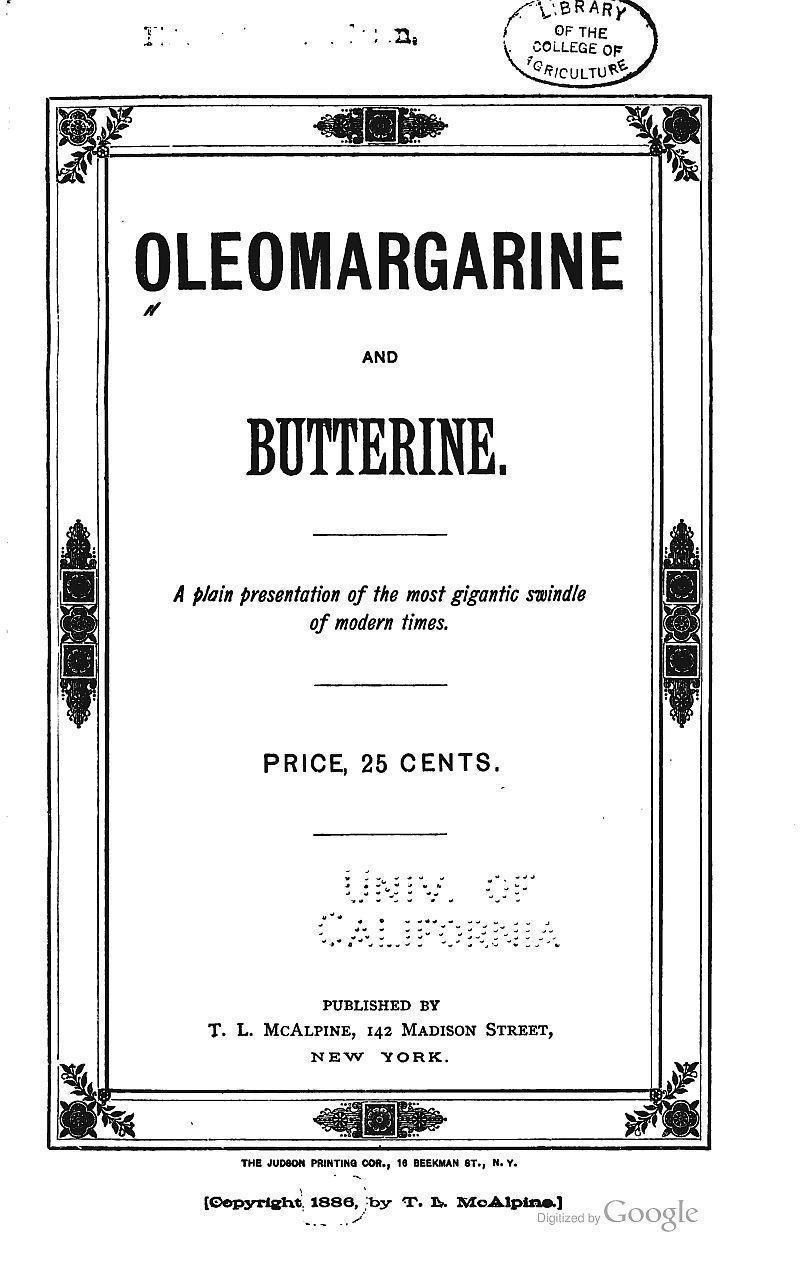 There were also unscrupulous vendors, like Twain’s oleomargarine drummer, who sold yellow-colored margarine but claimed it was butter. This practice of passing off yellow margarine led the State Dairy Commissioner of New York to comment in 1886: “There never was, nor can there ever be, a more deliberate, outrageous swindle than this bogus butter business.” According to the Commissioner, selling margarine as butter was a diabolical scheme “conceived in iniquity, nurtured by moonshiners, and carried out by desperate men.” Laws were needed to protect the public by those who perpetrated this “base fraud upon the people.” The dairy industry had many other legitimate concerns about margarine. The processing of margarine was inconsistent. Some of the ingredients were arguably unwholesome. Yet the primary concern was the fear of competition from yellow margarine. It was this fear that led to aggressive lobbying by the dairy industry in order to have laws passed to protect butter. And so began what have been called the “color wars”: the struggle between the margarine and butter industries in order to gain hegemony over table spreads.
There were also unscrupulous vendors, like Twain’s oleomargarine drummer, who sold yellow-colored margarine but claimed it was butter. This practice of passing off yellow margarine led the State Dairy Commissioner of New York to comment in 1886: “There never was, nor can there ever be, a more deliberate, outrageous swindle than this bogus butter business.” According to the Commissioner, selling margarine as butter was a diabolical scheme “conceived in iniquity, nurtured by moonshiners, and carried out by desperate men.” Laws were needed to protect the public by those who perpetrated this “base fraud upon the people.” The dairy industry had many other legitimate concerns about margarine. The processing of margarine was inconsistent. Some of the ingredients were arguably unwholesome. Yet the primary concern was the fear of competition from yellow margarine. It was this fear that led to aggressive lobbying by the dairy industry in order to have laws passed to protect butter. And so began what have been called the “color wars”: the struggle between the margarine and butter industries in order to gain hegemony over table spreads.
Brody’s family became involved in the bogus butter business soon after margarine was introduced into the United States. Brody told the press that it was his grandfather, John F. Jelke Jr., who had made his money in margarine. He did, but the Jelke family’s role in oleo had actually started two generations earlier, with Brody’s great-great-grandfather, Ferdinand Jelke. For centuries in the Nordhausen region of Germany, the Jelkes had been büttners—barrel makers—specializing in the casks used for holding schnapps. Ferdinand came to America in 1839 when he was ten years old. During his teenage years, his father taught him the family trade, and Ferdinand grew to be a fine barrel maker. In mid-19th century America, dry food stuffs and potable liquids were shipped in barrels, kegs, hogsheads or other wooden casks. Ferdinand’s experience as a cooper eased his way into business as America spread west beyond the Mississippi. He built barrels on the banks of the rivers in and around Cincinnati, but he also valued education and studied at night at Nelson’s Business College. He was good with arithmetic and soon became a bookkeeper for various concerns, eventually landing a position with a commission merchant. After about a year and a half, he founded his own company in 1850 and set off to become a commission merchant of butter, cheese, eggs, broom corn and broom corn supplies. Shortly after his eldest son, John Faris Jelke, was born in 1856, F. Jelke & Co. became F. Jelke & Son. Within a year of Mège-Mouriés’s invention, margarine made its way to America, and F. Jelke & Son was one of the first companies to sell it.
Ferdinand wanted to pass his business to his heirs. He had eight children, including four sons, but none of them took over the family business. One son died in childhood. The other three set off on their own. One became an attorney, later a judge. The youngest became a surgeon, having studied at Johns Hopkins in Baltimore and the University of Heidelberg. The eldest continued in his father’s business for a while but, in the late 1880s, came to believe that his future was in manufacturing margarine, not selling it as a commission merchant. He headed to Chicago, where the stockyards and slaughterhouses were located. The slaughterhouses could produce large quantities of pure animal fat, the key raw material needed to manufacture the butter substitute. There, Brody’s great-grandfather, John F. Jelke, would start amassing the family fortune that eventually passed from one oleomargarine heir to the next until it reached Brody.
In 1889, following his hunch that the stockyards of Chicago were the gateway to a margarine fortune, John F. Jelke started an Illinois corporation with George P. Braun and L.V. Fitts called the Braun & Fitts Company. The company’s margarine had a smooth texture and a rich taste. Perfect for cooking or using as a table spread, the company’s product had only one drawback. It was white, as were nearly all the legal margarines of the day. The dairy industry had made certain of that.
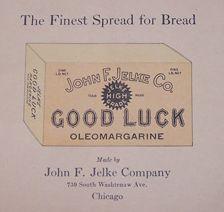 Almost as soon as margarine was introduced to America, the dairy industry began fighting to prevent the butter substitute from reaching the American table. Consumers associated butter with the color yellow. It was viewed as a wholesome and natural product. This view was odd since butter in its natural form varied in color from pale wheat to deep gold depending on a number of factors, including the breed of cow and its feed. To achieve a uniform yellow color, butter was often artificially colored, sometimes with carrot juice but more often with annatto, a yellow-reddish dye prepared from the pulp surrounding the seeds of the achiote tree found in Central and South America. Margarine could also be colored in this manner, and the dairy industry did not want a competitor product that looked and tasted like butter but cost much less.
Almost as soon as margarine was introduced to America, the dairy industry began fighting to prevent the butter substitute from reaching the American table. Consumers associated butter with the color yellow. It was viewed as a wholesome and natural product. This view was odd since butter in its natural form varied in color from pale wheat to deep gold depending on a number of factors, including the breed of cow and its feed. To achieve a uniform yellow color, butter was often artificially colored, sometimes with carrot juice but more often with annatto, a yellow-reddish dye prepared from the pulp surrounding the seeds of the achiote tree found in Central and South America. Margarine could also be colored in this manner, and the dairy industry did not want a competitor product that looked and tasted like butter but cost much less.
By the time John F. Jelke started his Illinois venture, the first skirmishes in the color wars were well underway. The dairy industry had attacked on several fronts. It waged a relentless propaganda and disinformation war, disparaging margarine at every turn. Margarine was depicted in dairy association newspapers as being the product of diseased cows, hogs, dogs and stray cats. There were allegations that it caused cancer or insanity. All of the allegations were backed up by scientists hired by the dairy industry. One such scientist, described as a microscopist, claimed to have studied the contents of margarine purchased from a Chicago vender. Professor Piper’s microscopic examination allegedly revealed that the “best samples had many kinds of living organisms in them, with masses of dead mould, bits of cellulose, various colored particles, shreds of hair, bristles, etc., while other samples teemed with life; doubtful portions of worms were also noticed…corpuscles from a cockroach, small bits of claws, corpuscles of sheep, the egg of a tape worm,… a dead hyrdaviridis.” In contrast, butter was depicted as wholesome and pure, coming from contented cows owned by friendly farmers. In the late 1870s and early 1880s, several states, swayed by the dairy industry’s propaganda, banned the manufacture of all types of margarine. In New York, the margarine industry challenged the law and prevailed. Based on admissible, scientific evidence (not propaganda and slander), the New York Court of Appeals found that margarine was a wholesome product, with essentially the same characteristics as butter; therefore, a total ban was not reasonably related to the state’s right to protect the public’s health, safety and welfare.
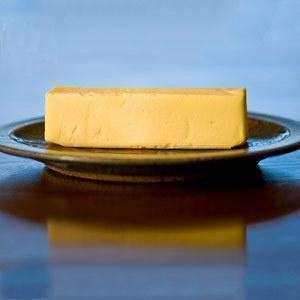 Concerned that other states would follow the New York decision, the dairy industry immediately asked the United States Congress for protection. The federal government answered by passing the Oleomargarine Act of 1886, which levied burdensome taxes and license fees on the margarine industry. Although the federal act made it more costly to manufacture and sell margarine, it did not address the primary evil that the dairy industry feared—competition from margarine colored yellow. The dairy industry turned its attention to the dairy states, convincing several to pass laws that banned the manufacture and sale of yellow margarine in order to avoid consumer confusion with butter. In 1894, the United States Supreme Court found that these laws were a constitutional exercise of a state’s police power: the authority to regulate in order to protect the health, safety and welfare of its citizens. The dairy industry did not rest with this victory, however.
Concerned that other states would follow the New York decision, the dairy industry immediately asked the United States Congress for protection. The federal government answered by passing the Oleomargarine Act of 1886, which levied burdensome taxes and license fees on the margarine industry. Although the federal act made it more costly to manufacture and sell margarine, it did not address the primary evil that the dairy industry feared—competition from margarine colored yellow. The dairy industry turned its attention to the dairy states, convincing several to pass laws that banned the manufacture and sale of yellow margarine in order to avoid consumer confusion with butter. In 1894, the United States Supreme Court found that these laws were a constitutional exercise of a state’s police power: the authority to regulate in order to protect the health, safety and welfare of its citizens. The dairy industry did not rest with this victory, however.
The dairy lobbyists next convinced a handful of states to pass laws that required margarine to be colored pink, ostensibly to avoid confusion with butter but, in reality, to give margarine an unappetizing appearance. Politicians of pro-dairy states openly discussed whether laws should be enacted requiring that margarine be colored green, blue or even black. Before these legislators could act, the pink laws were struck down in 1898 as unconstitutional by the United States Supreme Court. While a state had the right to prohibit the adulteration of natural margarine, including prohibiting anyone from coloring it yellow, it had no right to require that margarine be colored pink. Such a law was not rationally related to any concern about the health, safety or welfare of the people.
Other states passed more rational laws, but these were also designed to suppress margarine and promote butter. A few states required that margarine be appropriately labeled when sold by a retailer or that restaurant customers be told that margarine, not butter, was being served. Other states outlawed the manufacture, sale or service of any “fat, oil, or oleaginous substance” that imitated yellow butter and was not produced directly from cow’s milk. Such state laws gave the buttermen a clear economic advantage, but the dairy industry was still not satisfied. The front line of the color wars shifted to Washington, D.C., where the buttermen sought yet more federal protection.
In 1902, following extensive lobbying, the 57th Congress amended the Oleomargarine Act of 1886. Overtly protectionist, the 1902 amendments taxed artificially colored margarine at a rate forty times higher than its natural-white counterpart: ten-cents per pound for artificially colored margarine but only ¼ cent per pound when “free from artificial coloration that causes it to look like butter of any shade of yellow.” The ten-cents-per-pound tax was about one-half the retail price of a pound of margarine, making the selling of artificially colored margarine economically unsound, particularly during the summer when the price of butter usually dropped because of the abundance of milk. With the passage of the 1902 amendments, the dairy lobby had secured a decisive victory in the color wars. The margarine industry had been devastated. Jelke was undeterred. He bought out his partners and changed the company name to The John F. Jelke Company.
Soon after the 1902 amendments, John F. Jelke and other manufacturers of margarine found themselves in an economic death spiral. Marketing margarine in its natural white color had proved to be difficult. The public was used to a yellow table spread, and the butter lobby had succeeded in effectively outlawing the sale of yellow margarine in many states. The federal tax imposed on yellow margarine guaranteed that it could not be sold at a competitive price even in states where it was not prohibited. Faced with the oppressive state and federal laws, Jelke and the margarine companies decided that they would battle the butter forces with less direct means, some legal, others not.
Throughout the color wars, the lawmakers never thought about the consumer, who liked the price of margarine, tolerated its taste and hated its whiteness. In contrast, Jelke always had the consumer in mind. During the difficult early years of the color wars, as the dairy industry secured protection from the federal and state governments, Brody’s great-grandfather saw that the only hope for his company was to entice the primary consumer—the housewife—into buying margarine despite its whiteness.
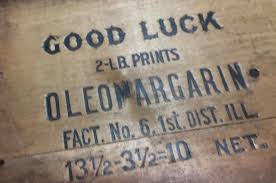 In the 1890s and early 1900s, both butter and margarine were placed in the stream of commerce in small wood casks called firkins. Each firkin, which could hold slightly less than 11 gallons, was held together with metal hoops. The firkins traveled from manufacturer to distributor to wholesaler to retailer. Customers who bought margarine would buy it much like today a customer might buy potato salad from a deli—by weight, a ¼ pound or ½ or a pound. The retailer would lift the lid and scoop the margarine from the firkin, weigh it, wrap it in paper or put it in a container supplied by the customer. Realizing that the housewife wanted a more convenient package, Jelke’s company began selling margarine in one- and two-pound blocks, called prints, wrapped in parchment. Consumers found the prints convenient to transport, store and use. For recipes, the one-pound block was easy to cut into measurable portions. While the firkin continued to be used for the sale of margarine from manufacturer to wholesaler to distributor, the one-pound print soon became the common way to sell margarine on the retail end. Later, Jelke’s company further improved the packaging by introducing the folding one-pound carton. Eventually, Jelke started selling margarine in four individually-wrapped quarter-pound sticks.
In the 1890s and early 1900s, both butter and margarine were placed in the stream of commerce in small wood casks called firkins. Each firkin, which could hold slightly less than 11 gallons, was held together with metal hoops. The firkins traveled from manufacturer to distributor to wholesaler to retailer. Customers who bought margarine would buy it much like today a customer might buy potato salad from a deli—by weight, a ¼ pound or ½ or a pound. The retailer would lift the lid and scoop the margarine from the firkin, weigh it, wrap it in paper or put it in a container supplied by the customer. Realizing that the housewife wanted a more convenient package, Jelke’s company began selling margarine in one- and two-pound blocks, called prints, wrapped in parchment. Consumers found the prints convenient to transport, store and use. For recipes, the one-pound block was easy to cut into measurable portions. While the firkin continued to be used for the sale of margarine from manufacturer to wholesaler to distributor, the one-pound print soon became the common way to sell margarine on the retail end. Later, Jelke’s company further improved the packaging by introducing the folding one-pound carton. Eventually, Jelke started selling margarine in four individually-wrapped quarter-pound sticks.
Jelke was one of the first to put a brand name on margarine. He called his product Good Luck margarine. He marketed it aggressively as both a table spread and a cooking ingredient. The company developed the slogan “The finest spread for bread” and, later, “Aw…spread it thicker.” For a trade symbol, the company used a Dutch girl, in a bonnet and clogs, which was described in its own literature as “the little Jelke GOOD LUCK girl in her quant Dutch costume and wooden shoes—symbol of purity and buying guide to the largest selling and most satisfactory margarine in America.” She was often depicted working in the kitchen with a mixing bowl and spoon, and a one-pound block of Good Luck margarine clearly visible on the kitchen table.
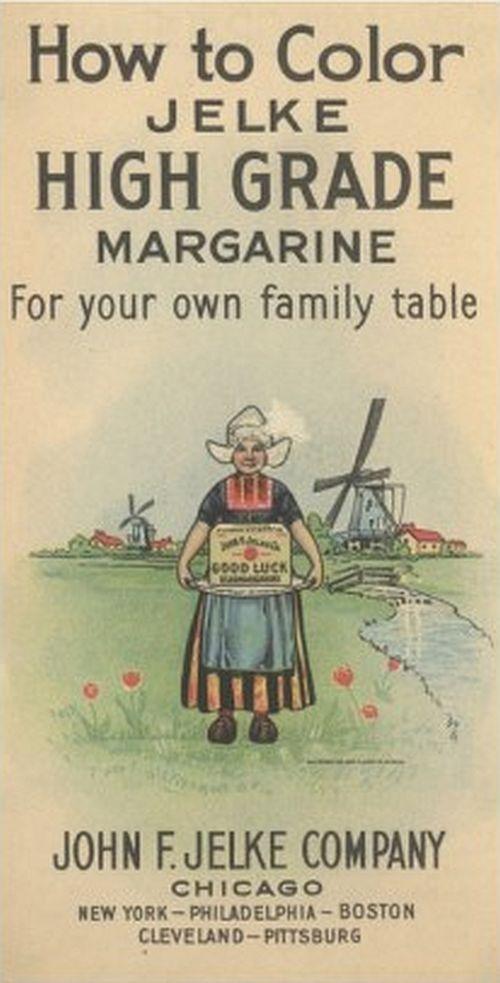 Jelke also sought ways to circumvent the 1902 amendments. Soon, he and the other margarine companies found a proverbial loophole in the law. Although the manufacture and sale of pre-dyed yellow margarine was outlawed or taxed, nothing prohibited the sale of white margarine that could be colored at home by the consumer. While some thought that no housewife would color margarine in the kitchen, Jelke was determined. Soon, nearly all companies, Jelke’s included, would market white margarine with a separate yellow dye wafer. Jelke called his dye the “Golden Glow” and claimed it was fortified with vitamins. The purchaser of the margarine, typically depicted in advertisements as a housewife, would put the dye wafer and the margarine in a bowl and knead them together. It was a perfect solution except for one thing: kneading the dye into the white margarine was messy and time consuming, and the end product rarely had a uniform color. The dye wafer was hard and had to be crushed with a fork, then ground, which was nearly impossible to do effectively. The crushed dye wafer then had to be melded into the margarine with a heavy spoon, a wrist-breaking chore that took twenty minutes. Even with extensive kneading, the end result was a bowl of white margarine with yellow-orange streaks, hardly an appetizing breakfast spread for toast or muffins. Although many consumers chose to eat this concoction because the price of white margarine was considerably lower than butter, it was clear that many more would purchase pre-colored yellow margarine if its price was right.
Jelke also sought ways to circumvent the 1902 amendments. Soon, he and the other margarine companies found a proverbial loophole in the law. Although the manufacture and sale of pre-dyed yellow margarine was outlawed or taxed, nothing prohibited the sale of white margarine that could be colored at home by the consumer. While some thought that no housewife would color margarine in the kitchen, Jelke was determined. Soon, nearly all companies, Jelke’s included, would market white margarine with a separate yellow dye wafer. Jelke called his dye the “Golden Glow” and claimed it was fortified with vitamins. The purchaser of the margarine, typically depicted in advertisements as a housewife, would put the dye wafer and the margarine in a bowl and knead them together. It was a perfect solution except for one thing: kneading the dye into the white margarine was messy and time consuming, and the end product rarely had a uniform color. The dye wafer was hard and had to be crushed with a fork, then ground, which was nearly impossible to do effectively. The crushed dye wafer then had to be melded into the margarine with a heavy spoon, a wrist-breaking chore that took twenty minutes. Even with extensive kneading, the end result was a bowl of white margarine with yellow-orange streaks, hardly an appetizing breakfast spread for toast or muffins. Although many consumers chose to eat this concoction because the price of white margarine was considerably lower than butter, it was clear that many more would purchase pre-colored yellow margarine if its price was right.
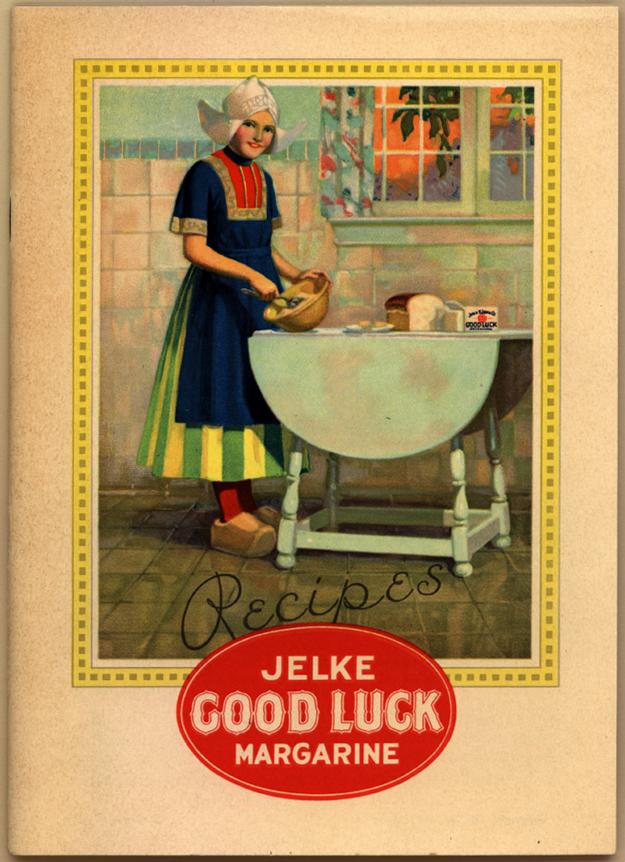 In a further effort to appeal to the American consumer, Jelke also distributed a pamphlet of recipes. Naturally, the majority of the recipes—for breads, cakes, soups, salad dressing, mayonnaise—called for Good Luck margarine. The few recipes that did not call for margarine included other Jelke products, like Good Luck evaporated milk. The pamphlet matured into longer books, published at various times under the simple descriptive name, Jelke’s Good Luck Margarine Recipes. Another book, entitled Good Luck Color Scheme Parties gave hints on how to host color-coordinated events in every hue: brown, orange, rose, pink, yellow, green, lavender and even rainbow. The recipes, each calling for Good Luck margarine, enabled the hostess to match her food to her flowers, candles, linens and tableware. Jelke also touted the freshness and purity of his product, proudly displaying the Good Housekeeping Seal of Approval.
In a further effort to appeal to the American consumer, Jelke also distributed a pamphlet of recipes. Naturally, the majority of the recipes—for breads, cakes, soups, salad dressing, mayonnaise—called for Good Luck margarine. The few recipes that did not call for margarine included other Jelke products, like Good Luck evaporated milk. The pamphlet matured into longer books, published at various times under the simple descriptive name, Jelke’s Good Luck Margarine Recipes. Another book, entitled Good Luck Color Scheme Parties gave hints on how to host color-coordinated events in every hue: brown, orange, rose, pink, yellow, green, lavender and even rainbow. The recipes, each calling for Good Luck margarine, enabled the hostess to match her food to her flowers, candles, linens and tableware. Jelke also touted the freshness and purity of his product, proudly displaying the Good Housekeeping Seal of Approval.
Jelke was a clever business man who knew that packaging and marketing could only go so far. Early on he realized one inescapable fact. For cooking and baking, the color of margarine did not mean much, but, as a table spread, white margarine fell far short. There was a huge market for yellow margarine, if only Jelke could tap into it. He along with the other margarine companies sought another loophole, one that would enable them to sell pre-colored yellow margarine legally and cost-effectively. Because the 1902 higher tax applied only to artificially colored margarine, Jelke landed upon the idea of adding a natural coloring ingredient to the manufacturing process. This way, he thought, the tax would not apply. Jelke experimented with various substances and finally decided that the yolks of Chinese duck eggs were the answer. Dried and pulverized into a fine powder, the yolks could be used as a natural additive to margarine to make it yellow and thus circumvent the tax on artificially colored margarine. He had started buying the powdered duck yolks from commission merchants in Germany, but he soon decided to cut out the middle man and go directly to the source. Securing a low-cost supply of duck eggs was an important matter not to be trusted with anyone but family.
Jelke and his wife, Louanna, had two children, both sons. The father wanted his boys to follow him in the margarine business. A trip to China on an important business matter was just the thing to groom them for the day they would take over his oleo empire. In the middle of the night, he dispatched the boys on the secret mission to the Orient: from Chicago, a train to San Francisco, then a Japanese steamer to Tokyo, a smaller coast vessel to Shanghai and an even smaller river steamer for the five-day journey up the Yangtze to Hankou. Called the “Chicago of China,” Hankou was a busy gateway city, lying strategically where the Yangtze met the Han. During the Boxer Rebellion a few years earlier, Hankou had been the escape route for occidentals fleeing the uprising. When the Jelke boys showed up in the city, the European powers were patrolling the river with gunboats, and the city itself teemed with European merchants trying to corner the Chinese market on one commodity or another. Neither Jelke boy had been trained for the trip. The elder boy was 22 and still in college; the younger one just 16 years old. They met with great resistance in Hankou. The Chinese egg merchants all had contracts with commission merchants in Germany and France, and the European merchants did not want to jeopardize their monopoly, but the boys persisted and eventually worked out a deal where eggs packed in cans were shipped directly from Hankou to The John F. Jelke Company’s plant in Chicago. Triumphant, the boys began the six-week journey home.
Almost immediately upon their return, however, their father abandoned the use of the dried egg yolks. He and the other margarine manufacturers had settled on another natural ingredient. The addition of a small amount of palm oil in the manufacturing process gave margarine a yellowish-brown, almost amber, hue. The companies publicly claimed that margarine made this way had a natural color and therefore was not subject to the higher tax. For a few years, this approach worked, but the United States Supreme Court eventually ruled that margarine colored with trace elements of palm oil was still artificially colored and thus subject to the higher tax. It was another blow to the margarine industry. Jelke became desperate.
Jelke had come to know many margarine moonshiners over the years—men who like the drummer in Twain’s Life on the Mississippi worshipped only one God, money. The moonshiners knew that there was a vast market for a cheap, yellow table spread, and the only way to exploit that market was to sell illegally colored margarine that appeared to comply with the federal tax law. It was just a matter of packaging, and the moonshiners knew all the tricks of illegally coloring and selling margarine. In these men, Jelke saw salvation for his company during the lean years following the 1902 amendments and particularly after the 1909 Supreme Court ruling that destroyed the margarine industry’s attempt to sell naturally colored margarine without the burdensome federal tax. If moonshiners wanted to break the law and color white margarine after it left Jelke’s hands, there was nothing that Jelke could do to prevent it. But Jelke also saw a benefit if he helped them. And so he did.
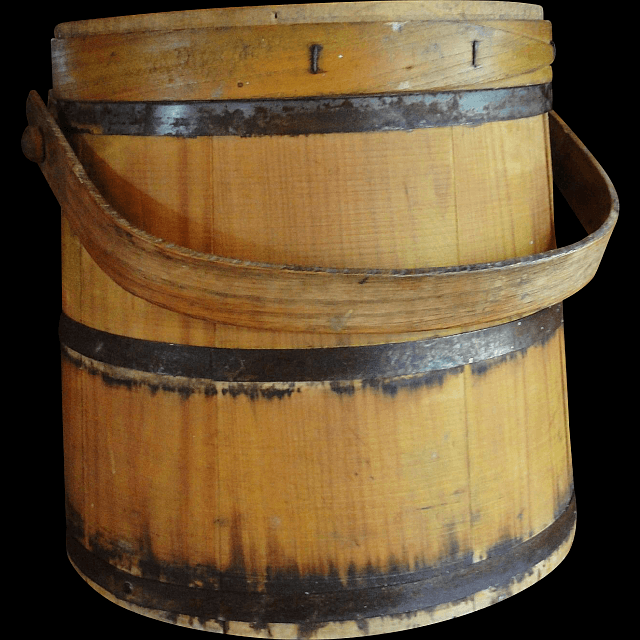 The federal government did not view Jelke’s assistance with amusement. In 1911, he was indicted by a federal grand jury for being part of a conspiracy to evade the taxes imposed upon colored margarine by the 1902 amendments. Judge Kenesaw Mountain Landis (later the first baseball commissioner) had ordered the investigation into the matter. According to the indictment, Jelke was the mastermind behind a plot that enabled moonshiners to sell yellow margarine that appeared to comply with the federal taxes. Under the 1902 amendments, each firkin of margarine placed into the stream of commerce had to bear a revenue stamp as evidence of the tax payment, which for yellow margarine was 40 times higher than its white counterpart. A typical firkin was held together by three metal hoops. The revenue stamps were customarily affixed to the middle hoop, which was called the bilge hoop. The centerpiece of the plot was a specially-designed firkin with a removable bilge hoop. According to the indictment, Jelke sold moonshiners one firkin of yellow margarine and dozens of firkins of white margarine in these special casks. The taxes were paid on each, and the revenue stamps were affixed to the removable bilge hoops. But the white margarine sold by Jelke to the moonshiners also had been specially manufactured: it was softer and more pliable than ordinary margarine. In addition, each of the firkins of white margarine contained about two pounds less than capacity. With each firkin of white margarine, Jelke provided two pounds of a color additive. Jelke had supplied the means and method to bootleg oleo.
The federal government did not view Jelke’s assistance with amusement. In 1911, he was indicted by a federal grand jury for being part of a conspiracy to evade the taxes imposed upon colored margarine by the 1902 amendments. Judge Kenesaw Mountain Landis (later the first baseball commissioner) had ordered the investigation into the matter. According to the indictment, Jelke was the mastermind behind a plot that enabled moonshiners to sell yellow margarine that appeared to comply with the federal taxes. Under the 1902 amendments, each firkin of margarine placed into the stream of commerce had to bear a revenue stamp as evidence of the tax payment, which for yellow margarine was 40 times higher than its white counterpart. A typical firkin was held together by three metal hoops. The revenue stamps were customarily affixed to the middle hoop, which was called the bilge hoop. The centerpiece of the plot was a specially-designed firkin with a removable bilge hoop. According to the indictment, Jelke sold moonshiners one firkin of yellow margarine and dozens of firkins of white margarine in these special casks. The taxes were paid on each, and the revenue stamps were affixed to the removable bilge hoops. But the white margarine sold by Jelke to the moonshiners also had been specially manufactured: it was softer and more pliable than ordinary margarine. In addition, each of the firkins of white margarine contained about two pounds less than capacity. With each firkin of white margarine, Jelke provided two pounds of a color additive. Jelke had supplied the means and method to bootleg oleo.
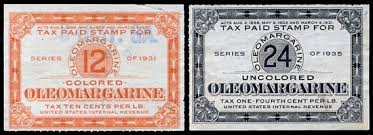 The moonshiner would sell the yellow margarine first. When the firkin was empty, the moonshiner would open a firkin of white margarine and mix in the two pounds of the color additive. Because the white margarine was soft and pliable, it was easy to mix right in the firkin. The color additive, a powder, added the necessary texture and hue. The end result was a firkin full of yellow margarine of the correct weight with the proper appearance. The moonshiner would then switch the bilge hoops on the two containers. Since the revenue stamps were fixed to the bilge hoops, it appeared that the firkin of newly-mixed yellow margarine complied with the federal tax law. The moonshiner would repeat this process, moving the bilge hoop with the revenue stamps for yellow margarine each time he mixed up a new batch of moonshined butter-hued margarine. In the end, the moonshiner effectively sold dozens of firkins of yellow margarine yet paid the higher tax only on one.
The moonshiner would sell the yellow margarine first. When the firkin was empty, the moonshiner would open a firkin of white margarine and mix in the two pounds of the color additive. Because the white margarine was soft and pliable, it was easy to mix right in the firkin. The color additive, a powder, added the necessary texture and hue. The end result was a firkin full of yellow margarine of the correct weight with the proper appearance. The moonshiner would then switch the bilge hoops on the two containers. Since the revenue stamps were fixed to the bilge hoops, it appeared that the firkin of newly-mixed yellow margarine complied with the federal tax law. The moonshiner would repeat this process, moving the bilge hoop with the revenue stamps for yellow margarine each time he mixed up a new batch of moonshined butter-hued margarine. In the end, the moonshiner effectively sold dozens of firkins of yellow margarine yet paid the higher tax only on one.
The government got wind of the conspiracy from the buttermen, and arrests followed. Jelke’s indictment was controversial. Many members of the public were sympathetic, for they wanted yellow oleo in the kitchen at an affordable price, and an evasion of an irrational tax hardly seemed deserving of prison time. Jelke’s attorneys tried to work out a deal with government, even making a plea directly to President William Howard Taft to dismiss the charges in return for Jelke’s paying a fine that would exceed the amount of the lost taxes. The Jelkes were Republicans and, like Taft, originally from Cincinnati. One of John F. Jelke’s brothers was a noted judge in Ohio who had been considered by Taft’s Republican predecessor, Theodore Roosevelt, several times for high government appointments. But Roosevelt and Taft had had a falling out in 1912. Taft was not about to help a Roosevelt supporter, and he refused to interfere in Jelke’s criminal prosecution.
The Roosevelt-Taft feud escalated, and Roosevelt bolted the Republican Party to run as a third-party candidate for president. Jelke’s hope that Roosevelt would win died when Woodrow Wilson, a Democrat, was elected. In February 1914, the trial began. The prosecution’s case was simple. Jelke facilitated the tax evasion by knowingly providing the means and methods for the moonshiners: the firkins with the removable bilge hoops, the soft and pliable white margarine and the coloring ingredient. Jelke argued that he could not control the margarine he sold once it left his possession. He also asserted that he did not benefit from the tax deception, for he sold wholesalers both white and yellow margarine at the same price. The prosecution easily picked apart the defense. Four weeks later, Jelke and eight of his co-conspirators were found guilty of conspiracy to evade the margarine tax. The government immediately threatened to confiscate The John F. Jelke Company’s main manufacturing plant in Chicago. To save the company, Jelke accepted full responsibility and asked the Court to be lenient on the eight co-conspirators. The judge fined seven of the co-conspirators but sentenced Jelke and another defendant to prison. Jelke was given two years in the penitentiary. He was also fined a sizeable amount. Appeals ensued but failed.